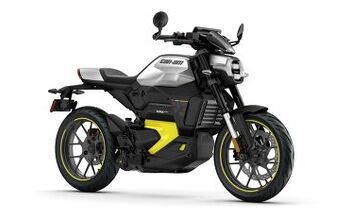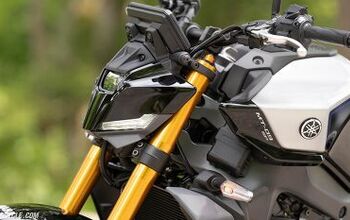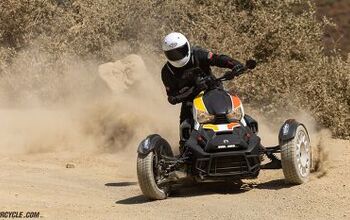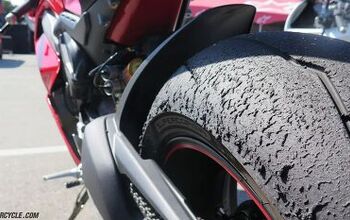2025 Can-Am Pulse & Origin Review – First Ride
BRP resurrects the historic Can-Am brand with two new Rotax-powered electric motorcycles
Any of you who were into motocross back in the ‘70s will surely recognize the Can-Am brand. The upstart Canadian company founded in 1972 quickly made a name for itself building motocross and enduro machines utilizing Rotax two-stroke engines. The white bikes with the red/yellow stripes swiftly earned race wins and championships, garnering a reputation as extremely fast with adequate handling. Rotax is a subsidiary of Can-Am parent company Bombardier, and the Austrian firm’s rotary-valve induction setup allowed them to crank out a good deal more horsepower than the competition. But Bombardier’s financial and development priorities unfortunately began to shift toward the end of the ‘70s, and the brand eventually disappeared by the late ‘80s.
Fast forward to the present day, and BRP (Bombardier Recreational Products, now spun off from parent company Bombardier) has resurrected the Can-Am brand in the motorcycle space. For a company that dominates the North American powersports market volume-wise with everything from the numerous Can-Am SxS and ATV models plus Spyder three-wheelers, to Sea-Doo/Manitou/Quintrex watercraft and Ski-Doo/Lynx snowmobiles, returning to the motorcycle market with the brand’s heritage required some serious thought before jumping back in. Interestingly, instead of a roadster or perhaps an ADV machine, the first new Can-Am motorcycles of the modern age are electric-powered.
BRP feels that electrification is where the market is headed in the next decade, and the new Pulse and Origin represent the first of several motorcycles to resurrect the storied Canadian brand (the Can-Am folk were expectedly tight-lipped about any details regarding future models, but it’s fairly obvious that they won’t be ICE-propelled bikes). The viability of the electric motorcycle market is certainly debatable, and Can-Am is obviously late to the party (we’ll get to all that later). But a close look at the bones that make up these two bikes reveals plenty of design innovation that separates them from the rest of the electric motorcycle sector.
Integrated Power Unit
Bombardier subsidiary Rotax is basically a power unit company, so Can-Am once again leveraged their expertise for the design of the new power/motor assembly. The unit is unique in that it’s a structural design; the battery pack, charger, inverter, controller, and motor are all bolted together, with the battery case forming the main load-bearing component of the assembly. The steering head is bolted to the front section of the battery case, while the swingarm (which contains the motor and drivetrain, more on that in a minute) pivots in a stamped steel framework attached to the rear; the rear shock attaches to the battery case as well. The modular design means that altering the steering geometry is as simple as bolting on a different steering head, as is the case between the Pulse and Origin.
Another unique feature is that instead of just liquid-cooling the battery or the motor, the entire E-Power unit including the battery pack, charger, inverter, and motor are all liquid-cooled. On the Origin, two small radiators (one in the case of the Pulse) below the steering head help dissipate the heat. Keeping temperatures stable pays obvious dividends for extending component life, especially with the motor and the battery. Liquid-cooling the battery means that charging doesn’t have to wait until the battery cools down, and quick-charging (which also generates heat in the battery) is also made easier.
In a design theme common to many scooters but not to motorcycles, the E-Power motor and drive system actually make up the bulk of the single-sided swingarm. The 35kW motor is mounted just aft of the swingarm pivot, and is good for about 47 peak horsepower. It drives a multi-link Hyvo-type silent chain at a 7.5:1 gear reduction ratio to the rear axle, with the chain, sprockets, and supporting guides and auto-tensioner fully enclosed in its own compartment. The sealed drive system means no dirt or rocks getting into the chain as well as constant lubrication; the Hyvo-type chain is far stouter and quieter than a conventional roller chain, with overall less maintenance (first oil change is at 5000 km, then oil changes at 10,000 km intervals; chain inspection doesn’t occur until 25,000 km).
Normally it would be concerning to have the weight of the motor on the swingarm (think unsprung mass), but because the motor is mounted very close to the swingarm pivot point, the majority of that mass’ effect on the suspension is negated. An additional plus with having the motor attached to the swingarm is that the anti-squat geometry (the forces of the rear wheel and chain pull counteracting the tendency of weight transfer to compress the rear suspension under acceleration) is optimized because there is no longer a variation in chain pull torque due to the countershaft sprocket being located forward of the swingarm pivot.
The battery has an energy capacity of 8.9kWh, which has its good and bad points. Good in that it’s not as bulky and doesn’t weigh as much as the larger capacity batteries commonly found on the other major brand electric bikes, so the Can-Ams are smaller and lighter. The bad—and it’s kind of a big one, at least in the case of the Origin, more on that later—is that range is significantly reduced. Both the Pulse and Origin have maximum ranges of under 100 miles, with real world limits more in the realm of 70 or so miles.
The 6.6kW on-board charger is Level 1 and 2 compatible, with the J1772 coupler allowing the battery to be fast-charged from 20-80% in a claimed 50 minutes, and 0-100% in 90 minutes. Using Level 1 charging and the huge 10.25-inch touchscreen dash (outfitted with Apple CarPlay for connectivity to your smartphone), you can set your charging to specific time and limits. Can-Am is confident enough in the battery construction to warranty it for five years (the bike itself for two years).
Another unique feature with the Rotax power unit is its “active regen” capability. Like most electric motorcycles, the Rotax has a “passive regen” capability, where anytime the bike is coasting off the throttle, the motor will be converting some of that energy back into the battery. The active regen is activated by rotating the throttle past fully closed; because of the additional energy conversion back into the battery, the drag is much greater. If you’re careful with the throttle, you can actually progressively apply more regen and slow the bike without using the brakes until almost at a complete stop. Both the passive and active regen features are adjustable to two levels, or off. There is also a reverse feature activated by pressing the start button and then rotating the throttle past fully closed.
Pulse
Intended as an urban commuter, the Pulse outfits the Rotax power unit with a naked/roadster-style theme and accommodations. A 41mm inverted non-adjustable KYB fork with 5.5 inches of travel up front and single Sachs rear shock sporting 5.5 inches of travel with adjustable spring preload out back roll on 17-inch cast aluminum wheels sporting Dunlop Sportmax GPR-300 rubber. Braking is handled by a single 320mm disc clamped by a J.Juan two-piston sliding caliper up front, with a 240mm disc/single-piston sliding caliper combo out back.
2025 Can-Am Pulse
Intended as an urban/suburban commuter bike, the Can-Am Pulse provides good acceleration with quick yet neutral handling manners. There are numerous features not found on other electric bikes that add value, including a fully liquid-cooled power pack and fully encased drive system. However, the $13,999 price tag and limited range compared to some other competitors might be an obstacle for some potential buyers.
Highs
- Light and nimble handling
- Active regen feature saves brake pads
- Enclosed chain case = low maintenance
Sighs
- Somewhat limited range
- $14K price tag a little high
- Motor could be a little stronger
Can-Am claims the Pulse weighs in at 390 pounds, and that figure felt about right. Snapping the throttle wide open from a stop results in acceleration that is right on par with 47 horsepower propelling under 400 pounds, although it feels slightly quicker than that due to the electric motor’s instant torque and lack of transmission gears. Nothing outrageous, but plenty quick enough to holeshot most any traffic, and the Pulse will continue to accelerate on up to the 80 mph speed limiter if you let it.
Handling is agile without being flighty, ideal for negotiating urban traffic and hazards. Suspension rates are a good compromise between comfort over gnarly pavement and control when changing direction at speed or using the brakes aggressively. And speaking of braking, the J.Juan brakes may be budget components, but the front brake’s power and feel was more than adequate for the Pulse’s intended use (the rear brake was a bit wooden-feeling by comparison).
About the only things we question with the Pulse are its range (about 70 miles of real world usage, not puttering about all day at 25 mph) and price ($13,999). The range can be looked at as acceptable considering its intended customer and environment, but for any real motorcycle enthusiast it’s probably a deal breaker. And while I understand the economics of manufacturing the Pulse, I still consider the price to be somewhat of a barrier; $14K is a big ask for a two-wheeler that many of those consumers will have difficulty justifying over the e-scooters traipsing around metropolitan areas in North America.
Can-Am Pulse Scorecard
Engine | 16/20 | Suspension | 10/15 | Transmission | 10/10 |
Brakes | 8/10 | Instruments | 4/5 | Ergonomics | 7.5/10 |
Appearance | 8.5/10 | Desirability | 7.5/10 | Value | 7.5/10 |
Editors Score: 79% | |||||
With the Origin, Can-Am finds itself in a bit of a quandary because of the bike’s potential. Intended as a dual-purpose machine, Can-Am could’ve just stuck on some adequate suspension and wheels and called it good. Instead, the components show that the company wanted to ensure it was far more than adequate off-road.
2025 Can-Am Origin
A surprisingly capable dual-purpose bike when it's off-road, with balanced handling, lighter weight than most ebikes, and decent suspension. It's a bit self-defeating, though; the Origin is good enough that you want to go off-road, but the limited range means only a select few can make it to their favorite spot and back without some sort of charging station nearby.
Highs
- Surprisingly capable off-road
- Enclosed chain case, good anti-squat
- Off-road modes work well
Sighs
- Limited range
- A bit pricey
- Did we mention limited range?
Up front, a non-adjustable KYB 43mm inverted fork sports a very generous 10 inches of travel, while a fully adjustable (rebound/compression damping, spring preload) KYB HPG shock provides 10 inches of travel out back. Dunlop D605 dual-purpose tires are budget-oriented and intended as 50/50 on/off-road rubber, but they are much better than many of the other OEM fitment tires you see on some ADV machinery. And the Dunlops roll on true off-road spoked rim sizes, with a 21-inch up front and 18-inch in the rear, both sporting tubes. The same front J.Juan 320mm disc and twin-piston slider caliper/rear 240mm disc and single-piston slider caliper combo as the Pulse is fitted to the Origin.
With the long-travel suspension, the Origin’s seat height correspondingly is rather tall at 34 inches, but it’s not as bad as it sounds. Even at 5’8” and 30” inseam, I didn’t have to sidestep that much to reach the ground, as the seat/tank junction is nice and narrow. The conventional handlebar has a good rise and pullback to set your torso in a comfortable ADV-style riding position, with big, serrated footpegs ensuring that your boots don’t slip when wet.
Even though it uses the same power unit, the Origin isn’t as quick as the Pulse off the line due to the larger diameter wheels and slightly heavier weight of 412 pounds (Can-Am claims a 4.3-second 0-60 mph time for the Origin, 3.8 seconds for the Pulse). Overall on-road handling with the Origin is nice and neutral, with the Dunlops displaying decent ride and grip despite their 50/50 bias.
The Origin has six ride modes: Eco, Rain, Normal, and Sport like the Pulse, plus Off-Road and Off-Road+. Both the Off-Road and Off-Road+ disable the rear ABS to allow locking the rear wheel, along with varying degrees of traction control and front ABS intervention.
The Can-Am people had an off-road course set up on a ranch that was more single-track in nature, with a lot of tight maneuvering through the small hills and trees that were scattered around the trail. My dirt riding skills are firmly in the novice skill set, so I tried the standard Off-Road mode and found the Origin to be very easy and forgiving to handle around the tight confines, with the rear TC allowing enough wheelspin to let me get the bike to do what I wanted. Switching to Off-Road+, the throttle response was more aggressive along with more wheelspin, and I found myself making some mistakes that had me switching back to Off-Road in order to avoid finding a 412-pound motorcycle on top of me. My dirt skills would probably find Off-Road+ better suited to faster fire road sections, although most of the better-skilled journos at the launch were fine with Off-Road+ in the single track.
Suspension action was excellent with no bottoming at my speeds, and the Origin steered nicely both on the throttle and off. The Dunlops displayed very good grip in everything but the silty turns (which would require a dirt-biased tire anyway), and braking manners were very solid and communicative. And while the course was mostly single-track, I never found myself wanting for more power.
The Origin is a surprisingly competent off-road machine for a dual-purpose electric bike, which would make its $14,499 sticker price at least somewhat palatable were it not for its one major Achilles Heel: its limited range. A real world range of 70 miles is simply a non-starter, as the vast majority of riders who like to ride off-road don’t have trails just outside their doorstep. And I’m not sure there are casual urban riders who’d be willing to spend that money for a bike with that capability that they can’t use.
Can-Am Origin Scorecard
Engine | 16/20 | Suspension | 13/15 | Transmission | 10/10 |
Brakes | 8/10 | Instruments | 4/5 | Ergonomics | 8.5/10 |
Appearance | 8.5/10 | Desirability | 7.5/10 | Value | 8/10 |
Editors Score: 83.5% | |||||
BRP feels that the electric motorcycle market is still an emerging category, just like the EV car industry was back in 2018-19. According to their research, there’s still a lot of interest in electric motorcycles, and their belief is that once interest rates start dropping, more potential customers will come out of the woodwork and the sector will become viable. And Can-Am wants to be there, already deeply involved in the electric motorcycle space with its vast dealer network, when that happens.
Let’s hope they’re right.
In Gear

- Helmet: Arai XD-5
- Jacket: Alpinestars Tailwind Air Waterproof
- Gloves: Alpinestars Atom
- Jeans: Dainese Airtex (Discontinued)
- Boots: Alpinestars RT-7
Specifications | Can-Am Origin | Can-Am Pulse |
|---|---|---|
Motor Type | ROTAX E-POWER, liquid-cooled | |
Power | 47 hp peak / 27 hp continuous (claimed) | |
Torque | Motor Peak: 53 lb-ft. from 0 to 4600 rpm (claimed) | |
Top Speed | 80 mph / 129 kph (claimed) | |
0-60 mph Acceleration | 4.3 seconds (claimed) | 3.8 seconds (claimed) |
Battery Type | Integrated, lithium-ion | |
Battery Capacity | 8.9 kWh | |
Cooling System | Liquid-cooled: battery, inverter and on-board charger | |
Estimated Range | City: 90 miles (145 km) Combined (WMTC): 71 miles (115 km) Sustained 50 mph (80 kph): 52 miles (84 km) | City: 100 miles (165 km) Combined (WMTC): 80 miles (130 km) Sustained 50 mph (80 kph): 55 miles (89 km) |
Function | Active Regen, Passive Regen | |
Charger | On-board charger: 6.6 kW (Level 1 & Level 2 compatible) | |
Connector | Type 1 J1772 | |
Level 2 Charging Time (240 V) | 50 min. (20-80%) 1 hour 30 min. (0-100%) | |
Level 1 Charging Time (120 V) | 3 hours 10 min. (20-80%) 5 hours 15 min. (0-100%) | |
Transmission | Clutchless direct drive | |
Final Drive | Chaincase with silent chain | |
Function | Reverse function | |
Swingarm | Single-sided swingarm | |
Rake / Trail | 30° / 4.6 inches | 27.2° / 4.0 inches |
Front Suspension | KYB 43 mm inverted fork; 10 inches of travel | KYB 41 mm inverted fork; 5.5 inches of travel |
Rear Suspension | KYB HPG shock with adjustable preload, compression rebound; 10 inches of travel | SACHS twin-tube coil-over shock with preload adjustment; 5.5 inches of travel |
Front Brake | J.Juan 2-piston floating caliper, 320 mm disc; ABS | |
Rear Brake | J.Juan 1-piston floating caliper, 240 mm disc; ABS | |
Front Tire | Dunlop D605 90/90 R21 (with tube) | Dunlop Sportmax GPR-300 110/70 R17 |
Rear Tire | Dunlop D605 120/80 R18 (with tube) | Dunlop Sportmax GPR-300 150/60 R17 |
Front Wheel | Spoked wheel, Carbon black 21 x 1.85 in. | Cast wheel 17 x 3.5 in. |
Rear Wheel | Spoked wheel, Carbon black 18 x 2.5 in. | Cast wheel 17 x 4.5 in. |
Colors | Standard: Bright White or Carbon Black ’73: Sterling Silver Satin | Standard: Bright White or Carbon Black ’73: Sterling Silver Satin with Carbon Black /Acid Yellow wheels |
Length | 86.8 inches | 79.9 inches |
Width | 33.9 inches | 37.3 inches |
Height | 55.7 inches | 46.1 inches |
Wheelbase | 59 inches | 55.6 inches |
Seat Height | 34 inches | 30.9 inches |
Ground Clearance | 10.8 inches | 5.7 inches |
Curb Weight | 412 lb (claimed) | 390 lb (claimed) |
Maximum Vehicle Load | 745 lb (claimed) | 723 lb (claimed) |
Display | 10.25 in. touchscreen display with BRP Connect | |
Navigation System | Apple CarPlay | |
Drive Modes | Normal, ECO, Rain, Sport, Off-Road, Off-Road+ | Normal, ECO, Rain, Sport+ |
Switchgear | Backlit handlebar control module | |
Traction Control | Motorcycle Traction Control | |
Vehicle Warranty | 2 years | |
Battery Warranty | 5 years / 31,068 miles | |
Extended Service | Available from 12 to 36 months for vehicle excluding battery | |
Standard Features | LED headlight Glove box with USB port LinQ anchor points Skid plate LinQ Windshield (’73) Signature LED lights (’73) Vehicle cover (’73) | LED headlight Glove box with USB port LinQ anchor points Skid plate LinQ gauge spoiler (’73) Signature LED lights (’73) Vehicle cover (’73) |
We are committed to finding, researching, and recommending the best products. We earn commissions from purchases you make using the retail links in our product reviews. Learn more about how this works.
Become a Motorcycle.com insider. Get the latest motorcycle news first by subscribing to our newsletter here.
More by Kent Kunitsugu












































Comments
Join the conversation
With options its going to top 20K.
And like everyone else thinks 70/80 miles,,à real joke!
Ill stick with my zero...
These bikes do look good and seem pretty fun to bop around town with. That being said, at this price I feel like they struggle to even make a case for themselves against something like a Livewire Del Mar much less against all the ICE competition. If these were $6k then they might make sense...at $14k+ no way.